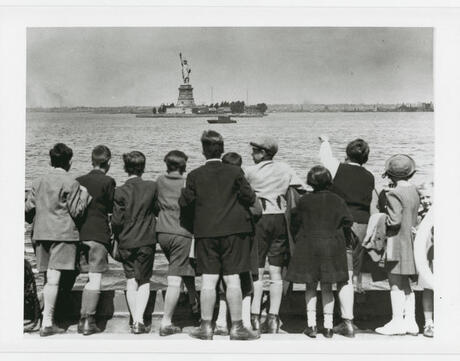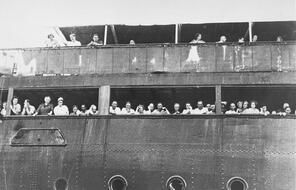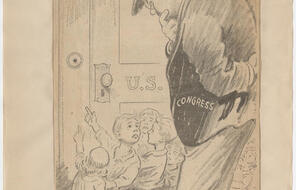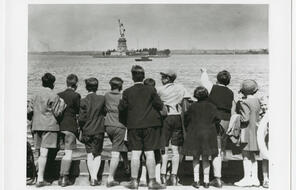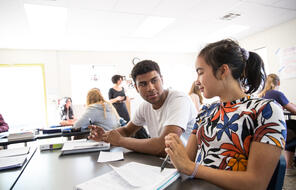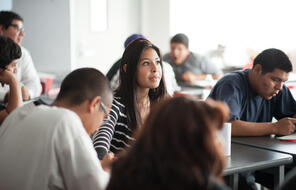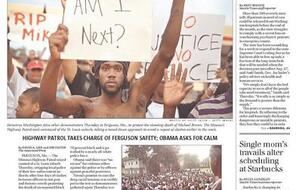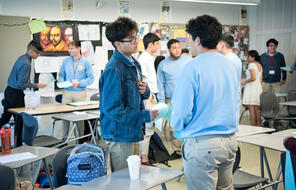During the 1920s, the US Congress passed laws that severely limited the number of immigrants who could enter the country each year. A series of restrictive legislative measures culminated in 1924 with the Johnson-Reed Act, which set quotas, or limits, on the number of immigrants from particular countries who could be admitted to the United States each year. Anti-immigrant sentiment, xenophobia, and antisemitism remained pervasive in the 1930s, influencing the political, economic, and social climate as Americans responded to the refugee crisis caused by the Nazi regime.
This crisis for European Jews and others seeking to escape the Nazi regime’s persecution intensified considerably in 1938, after Germany annexed Austria (the Anschluss) in March and the Sudetenland area of Czechoslovakia in September, bringing approximately 200,000 additional Jews under Nazi rule. President Roosevelt called for an international conference on the refugee crisis. Delegates from 32 countries gathered in Evian, France, in July 1938, but most countries refused to change their laws to assist Jewish refugees.
The American press criticized the 32 nations attending the Evian conference, including the United States, for their inaction. Most of the participants expressed sympathy for the refugees but offered little assistance, claiming that increased immigration might hurt their own nations’ economies. Some spoke bluntly about not wanting to admit Jews. Time magazine concluded: “All nations present expressed sympathy for the refugees but few offered to allow them within their boundaries.”
On November 9 and 10, 1938, the Nazi regime unleashed a wave of violent anti-Jewish pogroms throughout Germany. This nationwide attack on Jews, known as Kristallnacht, saw the arrest of 30,000 Jewish men and boys who were released from concentration camps only after agreeing to leave Germany as soon as possible.
In December 1938, prominent child psychologist Marion Kenworthy asked Clarence Pickett, the director of the American Friends Service Committee, a Quaker relief organization, to help lead an interfaith, non-sectarian effort to support legislation allowing refugee children from Europe to immigrate into the United States. Pickett immediately began to lobby members of President Franklin D. Roosevelt’s administration to support a child immigration bill, and he succeeded in convincing Secretary of Labor Frances Perkins and First Lady Eleanor Roosevelt.
In February 1939, Democratic senator Robert Wagner of New York and Republican congresswoman Edith Nourse Rogers of Massachusetts introduced legislation in Congress to admit 20,000 German refugee children under the age of 14 over a two-year period. The bill specified that the 10,000 children per year would enter the United States outside the existing restrictive immigration quota laws.
The authors of the Wagner-Rogers Bill tried to anticipate and address criticism by enlisting powerful allies. The American Federation of Labor supported the bill, claiming that the children would not add to the nation’s existing unemployment problem. The Children’s Bureau, an agency within the US Department of Labor, agreed to supervise the placement and care of the children. The Non-Sectarian Committee for German Refugee Children, headed by Pickett, promised that the children would be supported with private donations.
For the first time in her six years as First Lady, Eleanor Roosevelt allowed reporters to directly quote her in support of pending legislation. Referring to the ongoing Kindertransports, which brought German refugee children to Great Britain and western Europe, the First Lady said: “England, France, and the Scandinavian countries are taking their share of these children, and I think we should.” She also referred to the bill as a “wise way to do a humanitarian act.” Despite Mrs. Roosevelt’s urging, President Roosevelt never publicly commented on the Wagner-Rogers Bill.
The leaders of American Jewish organizations rarely lobbied for the bill publicly, perhaps because they were concerned that any attempt to prioritize aid for Jewish refugee children might spark increased antisemitism in the United States. Senator Wagner and Congresswoman Rogers, neither of whom were Jewish, emphasized that their bill would admit both German Jewish and Christian children, but opponents quickly branded the legislation as an effort to help Jewish refugee children primarily.
The House Committee on Immigration and Naturalization and the Senate Committee on Immigration held joint hearings on the Wagner-Rogers Bill in late April 1939. These initial hearings seemed to go well for the bill’s supporters, but opponents soon grew more vocal.
Democratic senator Robert Reynolds of North Carolina actively opposed the Wagner-Rogers Bill, giving multiple speeches against it on the Senate floor and asking constituents to voice their opposition. Reynolds warned that admitting refugees—even children—would increase unemployment. By the time he spoke out against the Wagner-Rogers Bill, Reynolds had already introduced five separate proposals in Congress to limit immigration, including one that would have banned all immigration either for ten years or until the unemployment rate dropped to historically low levels.
Senator Reynolds garnered support from the American Legion and the American Coalition of Patriotic Societies, which included members of the Daughters of the American Revolution and the Veterans of Foreign Wars. These groups officially supported a decrease in immigration to the United States overall and advocated that charitable efforts should be directed to impoverished American children instead of refugee children.
The American people agreed with Reynolds: 66 percent of Americans polled in January 1939 opposed expanding immigration to aid the refugee children. The Wagner-Rogers Bill never made it to a vote in Congress.
